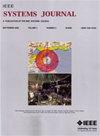DAMAGE: Directed Heterogeneous Network Attack Sequence Inference Through Graph Attention Matrix Generation Embedding and Reinforcement Learning
IF 4.4
3区 计算机科学
Q1 COMPUTER SCIENCE, INFORMATION SYSTEMS
引用次数: 0
Abstract
Distributed heterogeneous multiagent systems (DHMASs) link geographically dispersed agents through networks, harnessing information technology to foster collaboration. Considering the mainstream status of wireless communication in modern multiagent systems and the differences in the performance of interagent communication devices, we believe that it is appropriate to use directed heterogeneous networks (DHNs) to model distributed heterogeneous multiagent systems. This model not only reflects the directionality of interagent communication but also reflects the complexity of communication due to performance differences, thus providing a more accurate framework for understanding and optimizing system behavior. The study of disintegration in DHNs is vital for enhancing the decision-making agility of DHMAS. We introduce损害:通过图注意矩阵生成嵌入和强化学习的定向异构网络攻击序列推断
分布式异构多代理系统(DHMASs)通过网络连接地理上分散的代理,利用信息技术促进协作。考虑到无线通信在现代多智能体系统中的主流地位和智能体间通信设备的性能差异,我们认为使用定向异构网络(dhn)来建模分布式异构多智能体系统是合适的。该模型不仅反映了智能体间通信的方向性,也反映了由于性能差异而导致的通信复杂性,从而为理解和优化系统行为提供了更准确的框架。研究DHNs的解体对提高DHMAS的决策敏捷性具有重要意义。我们通过图注意矩阵生成嵌入和强化学习(DAMAGE)引入有向异构网络攻击序列推理,这是一种在归纳推理框架内集成图神经网络和强化学习的算法。该算法旨在优化分解策略的生成,提高网络分解过程的效率。该方法采用了一种有向网络嵌入技术和一个图注意矩阵生成模块,增强了对不完全网络结构信息的利用。通过烧蚀研究,我们证明了损伤算法不仅在完美拓扑条件下提高了网络分解的有效性,而且在不完美拓扑条件下保持了网络分解的鲁棒性。
本文章由计算机程序翻译,如有差异,请以英文原文为准。
求助全文
约1分钟内获得全文
求助全文
来源期刊

IEEE Systems Journal
工程技术-电信学
CiteScore
9.80
自引率
6.80%
发文量
572
审稿时长
4.9 months
期刊介绍:
This publication provides a systems-level, focused forum for application-oriented manuscripts that address complex systems and system-of-systems of national and global significance. It intends to encourage and facilitate cooperation and interaction among IEEE Societies with systems-level and systems engineering interest, and to attract non-IEEE contributors and readers from around the globe. Our IEEE Systems Council job is to address issues in new ways that are not solvable in the domains of the existing IEEE or other societies or global organizations. These problems do not fit within traditional hierarchical boundaries. For example, disaster response such as that triggered by Hurricane Katrina, tsunamis, or current volcanic eruptions is not solvable by pure engineering solutions. We need to think about changing and enlarging the paradigm to include systems issues.
 求助内容:
求助内容: 应助结果提醒方式:
应助结果提醒方式:


